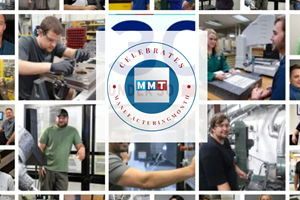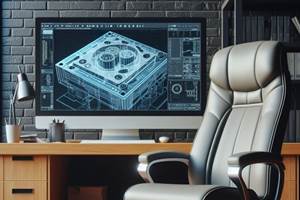Breaking the Mold in Training and Education
The industry cannot rely on the schools or government to train its future moldmakers - industry itself must take the lead.
Roland Gerstenberger - program manager for the East Central Florida Machine Trades Apprenticeship Program - recently spoke with senior editor Sherry Baranek and explained his role in the creation of Florida's Advanced Technology Center (ATC) - an educational partnership between Volusia Country Schools, Flagler County Schools, Daytona Beach Community College (DBCC), Volusia Flagler Charter Technical Career Center, Inc. and the business communities of Volusia and Flagler counties. Construction on the 155,000-square-foot. building is set to be complete in the summer of 2001. Classes will begin in August 2001, where high school students can complete their graduation requirements while taking courses in moldmaking and adults can pursue an associate's degree in technology-based fields or brush up on their technological skills.
Please tell us a little bit about yourself and the apprenticeship program.
Born and raised in Germany, I served an apprenticeship as a tool and die maker/ moldmaker. In Germany we combine them into one skill path where moldmaking would be a special part of that skill path. I immigrated to the states in 1957, graduated from the University of Miami with a degree in mechanical engineering and owned several manufacturing companies through-out my life, selling the last one in 1996. When I was semi-retired I was involved with the apprenticeship program. I have always felt that the availability of on-the-job training for skilled industries is few and far between in this country. Having been brought up in a culture where these types of training opportunities have been in place since practically the Middle Ages, it's a shame that we don't have enough good training programs here in the U.S.
There are five different skill paths in the apprenticeship program: moldmakers, tool and die makers, machinists and machine repairers. More than 60 percent of the program is made up of moldmakers and tool and die makers. We are currently in our third year and have 41 people in the program. I was involved in creating the program with local industry and the DBCC in 1996, so I've been associated with the program since its inception.
Since the DBCC is a major partner with the ATC, we will move over to the ATC when the center is complete and expand our current program. Right now we can only accept apprentices 18 years old and older. When the ATC is built, there will be high school juniors and seniors in attendance that we can expose to moldmaking and skilled trades prior to them entering the apprentice program.
Why was the ATC created? Why is it necessary?
The bottom line is that we want to expose young people to this industry and the skilled trades while they are in their junior and senior years so that they can make intelligent decisions as to what they want to do with their lives. The ATC offers students a regular high school curriculum in their last two years, but also offers an exposure to technical careers if they are interested. We're going to have wonderful, state-of-the-art labs and machine shops so that these youngsters - while working on their regular high school diploma and taking regular high school courses - can also take advantage of learning about the skilled trades.
What makes the ATC unique is the partnership between school and community. The ATC will offer the last two years of high school and the first two years of post-secondary education. So a typical student will enter in his junior year and while taking his regular courses can also look into machine shop, machining, CAD or any number of technical training areas. Once he or she has graduated from high school, they can enter the apprenticeship program, move on to an associate's degree in manufacturing technology from the DBCC or go beyond that into a four-year program.
It's a seamless program for youngsters aware of opportunities in technical and skill education, and that's the guiding thought behind it. To the best of our knowledge, such a combination has never been attempted in the United States. If you go back to some of the vocational high schools you will find that they have gotten a very bad reputation as they grew. They became sort of the dumping grounds for, and let me put this very carefully - undesirables - anybody that couldn't do anything else got dumped in vocational high schools. So we don't even use the word vocational anymore. The typical student entering the ATC will still attend and graduate with his own original high school class, and there's a very good reason for that - we want to attract some good students who don't want to necessarily attend college, yet still want to graduate with their classmates. We were very careful to work this in because we know that it takes just as much intelligence and stamina to go into a skilled area as it does to attend college. We would really like to break the mold, so to speak, of pushing everyone into college because there are real opportunities in the skilled industries. There's a need for them in this century.
What role did you play in the creation of the ATC?
The apprenticeship program was very instrumental in getting the facility, establishing the curriculum and selecting the equipment. As a matter of fact, I'm the chairman for the advisory committee on equipment and manufacturing technology. We needed the industry involved from the beginning because we wanted to ensure that whatever the product of this school is, it will be what the industry needs, not what academics think we need.
How can a community undertake this endeavor?
The industry cannot rely on the schools or government to train our future moldmakers - industry must take the lead because we recognize what we need and what quality of workers we need in order to produce. That's the key to it all. Industry must join forces with the academic world, and it has been a struggle. We are three separate entities that normally only look at each other, and having to look in the same direction has not been easy. There have been some hurdles - we were supposed to get $4 million from the state and it got vetoed this year, but we will go for it again next year. It was mainly for equipment, but we've been able to manage. For our program, we have a grant that takes care of the equipment and a number of equipment manufacturers are actually coming in and letting us use brand new equipment or are actually furnishing it for us, so it's been a great cooperative effort. Training programs seem to have fallen by the wayside, and in this area the average age of the tool and die maker is about ready to retire. Companies need to recognize this and put the effort in to grow their own employees and that's what has happened in this area. Cooperation between industry and education is vital.
When do classes start at the facility? What are the course offerings?
The building is currently under construction. We expect to move equipment in the building in June for classes to open in late August 2001.
We have developed specific courses for our program - we have programs developed just through the third year and are currently working on the fourth year. We're also planning to use experienced moldmakers as instructors. The problem with experienced moldmakers is that while they may be great moldmakers, they have little teaching experience, and it's not always easy to get the material across. So, if we can develop an interactive CD-ROM and match those years of experience with people that can put it into an educational format, it will be great, and that's what we're hoping to accomplish. We have an impressive pool of mentors that I draw from - they are really dedicated to passing on their experiences to the young people.
We are doing a bit of trailblazing here, but we really have a wonderful program with very good support from the industry - and that is what it takes, along with a great group of mentors.
Explain the concept of distance learning as it applies to the course curriculum.
Distance learning is especially designed for the moldmaking students in their third and fourth year. Our moldmaking classes are relatively small in those years and we are going to use interactive CD-ROMs to teach. The students - rather than sitting in a classroom - will most likely get their instruction from a computer at home. This is part of utilizing the latest in technology and teaching aids and it really works. As a matter of fact, right now our machine-building group is very small so I don't have them in a classroom, I have them in a computer lab on interactive CDs that we have purchased. They are great instructional tools. The technology is here - we just need to apply it to our own trade.
What's in store for the future at the ATC?
Initially the facility will be built to take care of 1,000 full-time students. It's been a great cooperative venture between industry, the school board and DBCC. We also will use the school - since we are going to have state-of-the-art facilities - for short-term training like CNC machining or evening adult educational training. Besides that, we are going to have vocational students come in, so we will use the facility to its utmost. There will be other areas that will be addressed in future phases of the facility - we are looking into the health care field. We have more than 100 acres available and are only using about 10 of those now, so this is just phase one.
Related Content
30 Under 30: The New Face of Moldmaking
Young professionals are vital to the moldmaking industry, and it is important to acknowledge those making strides in shaping the industry's future. MoldMaking Technology recognizes the industry's young talent through its inaugural 30-Under-30 Honors Program.
Read MoreHow to Improve Your Current Efficiency Rate
An alternative approach to taking on more EDM-intensive work when technology and personnel investment is not an option.
Read MoreTackling a Mold Designer Shortage
Survey findings reveal a shortage of skilled mold designers and engineers in the moldmaking community, calling for intervention through educational programs and exploration of training alternatives while seeking input from those who have addressed the issue successfully.
Read MoreThe Role of Social Media in Manufacturing
Charles Daniels CFO of Wepco Plastics shares insights on the role of social media in manufacturing, how to improve the “business” side of a small mold shop and continually developing culture.
Read MoreRead Next
Are You a Moldmaker Considering 3D Printing? Consider the 3D Printing Workshop at NPE2024
Presentations will cover 3D printing for mold tooling, material innovation, product development, bridge production and full-scale, high-volume additive manufacturing.
Read MoreReasons to Use Fiber Lasers for Mold Cleaning
Fiber lasers offer a simplicity, speed, control and portability, minimizing mold cleaning risks.
Read MoreHow to Use Strategic Planning Tools, Data to Manage the Human Side of Business
Q&A with Marion Wells, MMT EAB member and founder of Human Asset Management.
Read More






.jpg;maxWidth=300;quality=90)









.png;maxWidth=300;quality=90)



_300x250 3.png;maxWidth=300;quality=90)








